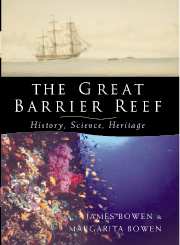Book contents
- Frontmatter
- Contents
- Abbreviations and Acronyms
- Preface
- Acknowledgments
- Introduction: An Overview
- Part One NAVIGATORS AND NATURALISTS IN THE AGE OF SAIL
- Part Two A NEW ERA IN REEF AWARENESS: FROM EARLY SCIENTIFIC INVESTIGATION TO CONSERVATION AND HERITAGE
- Chapter 11 ORIGIN AND STRUCTURE OF CORAL REEFS: FROM FORSTER TO DARWIN
- Chapter 12 DARWIN'S LEGACY: CORAL REEF CONTROVERSY 1863–1923
- Chapter 13 EXPLOITATION CHALLENGED: RISE OF ECOLOGY
- Chapter 14 REEF RESEARCH AND CONTROVERSY: 1920–1930
- Chapter 15 THE LOW ISLES EXPEDITION, 1928–1929: PLANNING AND PREPARATION
- Chapter 16 BIOLOGICAL RESEARCH OF THE LOW ISLES EXPEDITION
- Chapter 17 FROM DEPRESSION TO WAR: TOURISM, CONSERVATION AND SCIENCE, 1929–1939
- Chapter 18 THE PACIFIC WAR AND ITS AFTERMATH
- Chapter 19 A NEW PROBLEM: THE CONSERVATION CONTROVERSY, 1958–1972
- Chapter 20 CRISIS RESOLUTION: FORMATION OF AN ENVIRONMENTAL MANAGEMENT AUTHORITY
- Chapter 21 A NEW ERA: RESEARCH BASED MANAGEMENT
- Chapter 22 THE REEF UNDER PRESSURE: RESEARCH AND MANAGEMENT
- Chapter 23 THE REEF AS HERITAGE: A CHALLENGE FOR THE FUTURE
- References
- Index
Chapter 19 - A NEW PROBLEM: THE CONSERVATION CONTROVERSY, 1958–1972
from Part Two - A NEW ERA IN REEF AWARENESS: FROM EARLY SCIENTIFIC INVESTIGATION TO CONSERVATION AND HERITAGE
Published online by Cambridge University Press: 22 September 2009
- Frontmatter
- Contents
- Abbreviations and Acronyms
- Preface
- Acknowledgments
- Introduction: An Overview
- Part One NAVIGATORS AND NATURALISTS IN THE AGE OF SAIL
- Part Two A NEW ERA IN REEF AWARENESS: FROM EARLY SCIENTIFIC INVESTIGATION TO CONSERVATION AND HERITAGE
- Chapter 11 ORIGIN AND STRUCTURE OF CORAL REEFS: FROM FORSTER TO DARWIN
- Chapter 12 DARWIN'S LEGACY: CORAL REEF CONTROVERSY 1863–1923
- Chapter 13 EXPLOITATION CHALLENGED: RISE OF ECOLOGY
- Chapter 14 REEF RESEARCH AND CONTROVERSY: 1920–1930
- Chapter 15 THE LOW ISLES EXPEDITION, 1928–1929: PLANNING AND PREPARATION
- Chapter 16 BIOLOGICAL RESEARCH OF THE LOW ISLES EXPEDITION
- Chapter 17 FROM DEPRESSION TO WAR: TOURISM, CONSERVATION AND SCIENCE, 1929–1939
- Chapter 18 THE PACIFIC WAR AND ITS AFTERMATH
- Chapter 19 A NEW PROBLEM: THE CONSERVATION CONTROVERSY, 1958–1972
- Chapter 20 CRISIS RESOLUTION: FORMATION OF AN ENVIRONMENTAL MANAGEMENT AUTHORITY
- Chapter 21 A NEW ERA: RESEARCH BASED MANAGEMENT
- Chapter 22 THE REEF UNDER PRESSURE: RESEARCH AND MANAGEMENT
- Chapter 23 THE REEF AS HERITAGE: A CHALLENGE FOR THE FUTURE
- References
- Index
Summary
CONSERVATIVE ASCENDANCY: UNRESTRAINED EXPLOITATION, 1953–1968
By 1958, the three Reef island research stations – Heron, One Tree and Lizard – were still, in world terms, small, under-resourced, and limited to vacation and short term projects by individuals or small groups, yielding at best, the random unrelated results that had bothered Talbot. The British Low Isles Expedition of 1928–29 thirty years earlier had made the only major in-depth study within the Reef since Mayor's in 1913, which Australians still had no prospect of emulating. Nor did any of the Reef stations enjoy the advantages of the Enewetak Marine Biological Laboratory (EMBL), nor the lavish funding provided. At the end of the 1960s that situation was to change markedly; Reef science was to enter, for the first time, a new phase of development as the Commonwealth and Queensland governments were forced to recognise, after pleas for assistance for almost a century, that it was a seriously neglected area that had to be remedied.
Yet, the stimulus to research and funding came, not as a positive response to scientists' requests, but negatively when the Reef became the catalyst for what a national newspaper called the ‘most sustained public campaign in memory on a conservation issue’ ever experienced in Australia after people had mobilised in their thousands under the slogan ‘Save the Barrier Reef’ (The Australian 24 December 1969).
- Type
- Chapter
- Information
- The Great Barrier ReefHistory, Science, Heritage, pp. 317 - 336Publisher: Cambridge University PressPrint publication year: 2002

